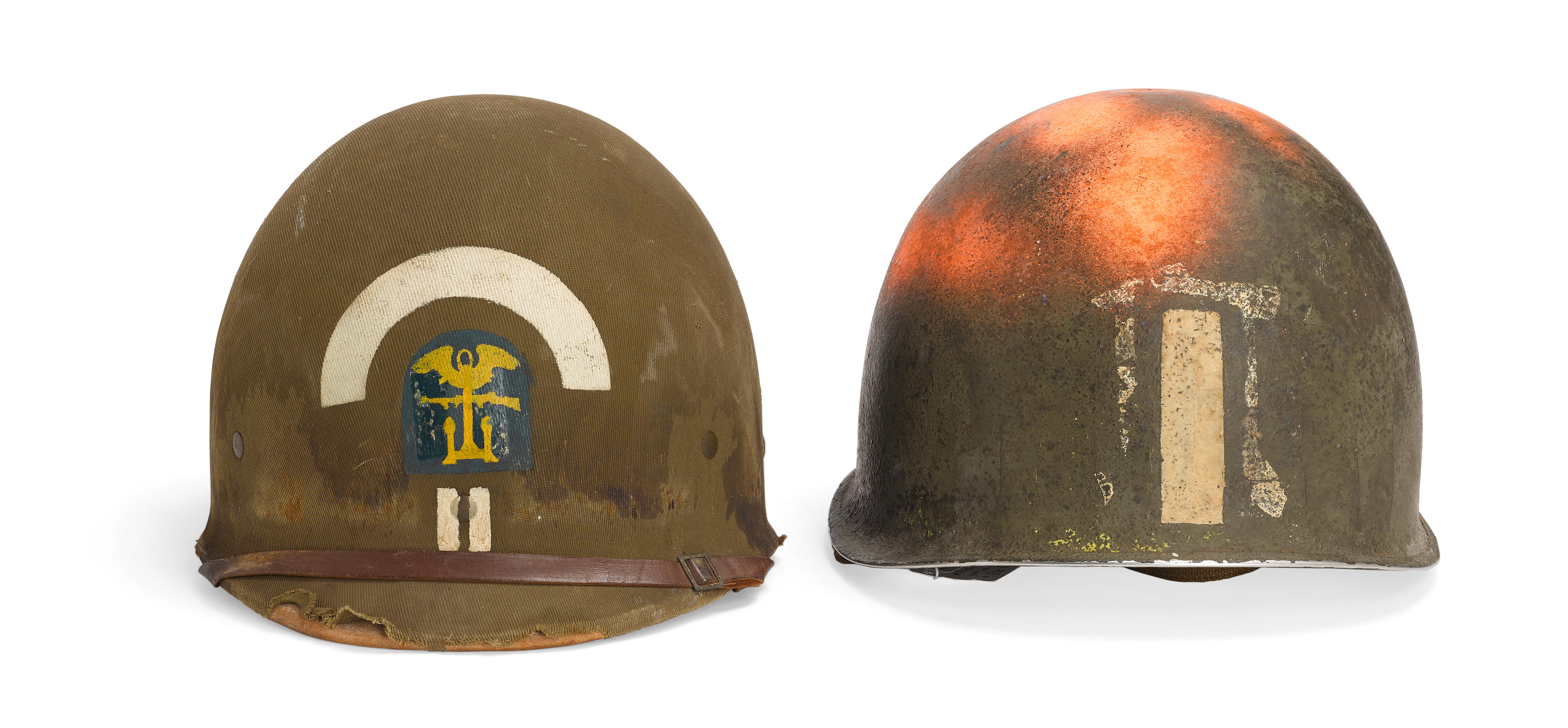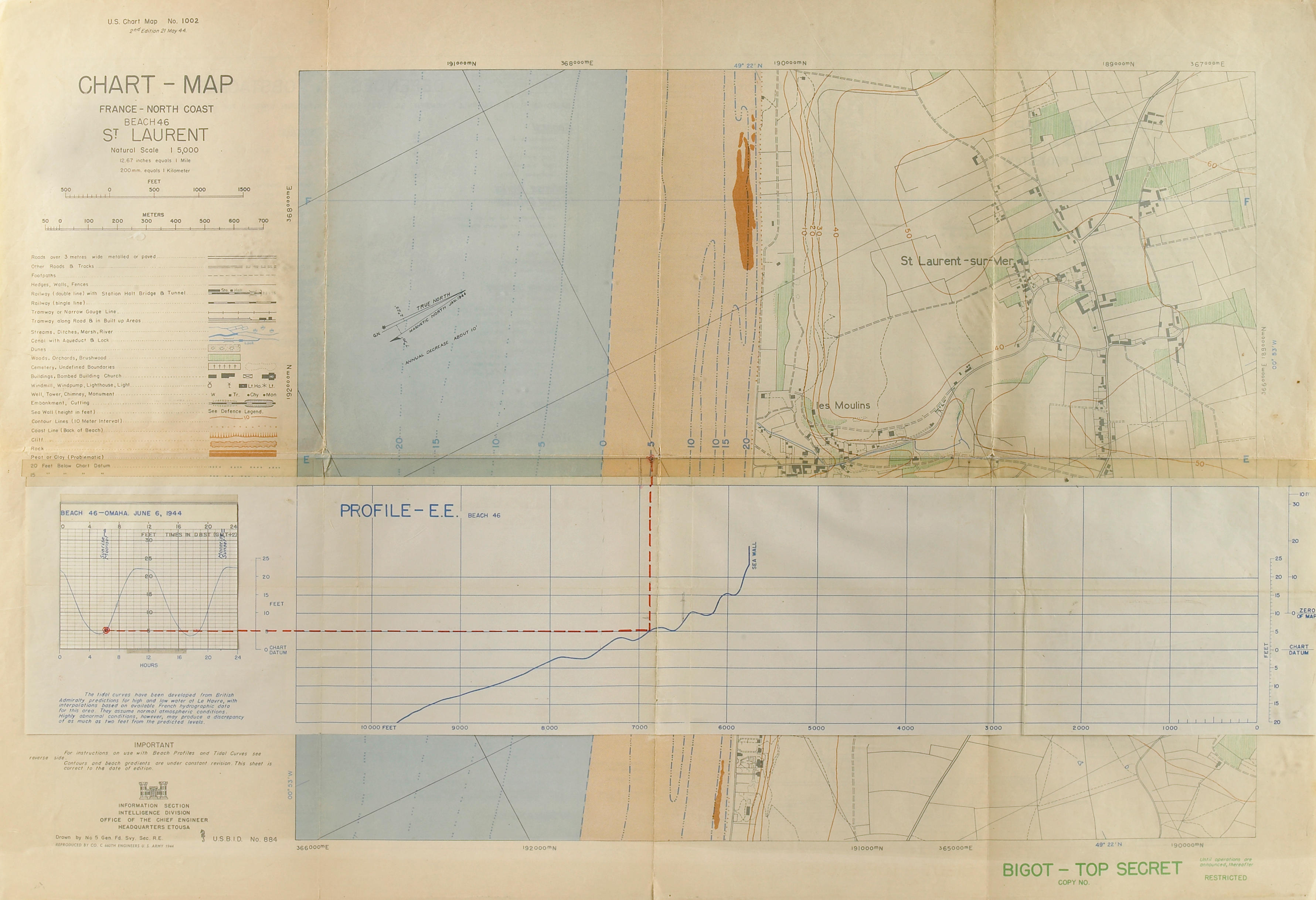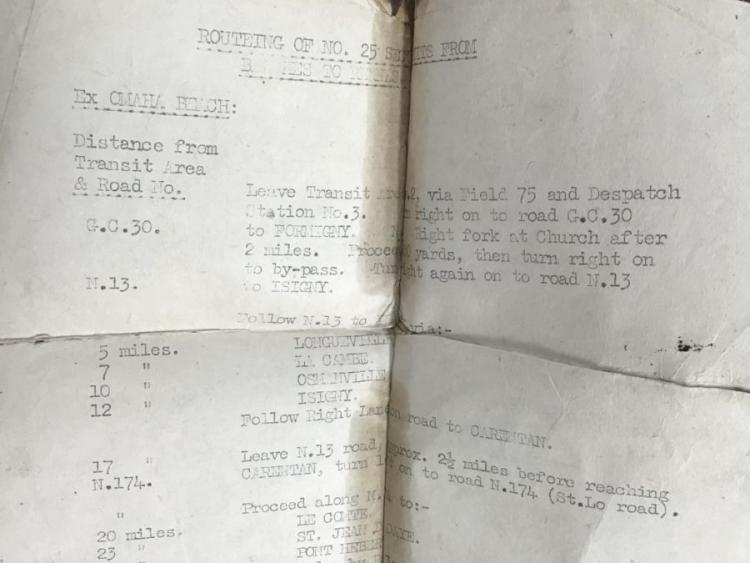Omaha Beach - West (Colleville-sur-Mer). Second Beach Obstacle Overprint - Information as of 30 May. At bottom "Top Secret - bigot Until Departure for Combat Operations - then this sheet becomes Restricted." Framed, double-glazed so both sides are visible. 24.25 x 19.5 in. (sight). Top 2/3 or so is a plan view of the western part of the beach, just about 6000 yards of it. The later information notes additional beach and land obstacles, such as fishnets, hedgehogs, tetrahedrons, anti-tank ditches, and mine fields. Just above the "Second Overprint..." note is a line with "Fox Red ----- Fox Green -------Easy Red------Easy Green" across the map, with "Dog Red" along margin where it meets the West map. Presumably these were the companies assigned to take the area of the beach just above. This area had many obstacles, especially just offshore. Extensive legends mark tidal or mud flats, marsh land, trees, orchards, hedges, dunes, gravel, cliffs, slopes, rocky cliffs, etc. Below the plan view is a panoramic photographic view - as the pilots of the landing craft would see it, with landmarks noted. However, in the legend of the map is a note to Coxswains or Navigators: "Building landmarks, especially near the beach, may be destroys any craft land. Terrain features, therefore, are much more reliable for visual navigation from panoramic shoreline sketch above.... Also on reverse side are Sunlight and Moonlight Table, data on Inshore Currents and Tidal Stages." ________________________________________________________________ Planning for the invasion of Europe began in 1943 at the Trident Conference in Washington in May of that year. A draft of the plan was accepted at Quebec in August, with Dwight Eisenhower as commander of the Allied Expeditionary Force and Bernard Montgomery as commander of the land forces. The coastline was divided into five landing beaches - Utah, Omaha, Gold, Juno and Sword. Utah was on the Cotentin Peninsula, which juts north into the English Channel, so its orientation is almost North-South. Where the peninsula meets the Normandy coast, the other beaches run primarily East-West. American forces were responsible for Utah and Omaha Beaches and British forces for Gold and Sword Beaches, with Canadian forces at Juno. Mixed in were Free French, Polish and other contingents (Belgium, Czechoslovakia, Greece, Netherlands, Australia, New Zealand, Norway, etc.) A swampy area separated the two areas, essentially cutting off the Utah Beach forces. Omaha's high rocky cliffs resulted in the heaviest casualties for those forces. The forces for the five beaches finally met about a week later. It would still take a month for Allied forces to gain firm control of Normandy. Condition: Not removed from frame for examination. Small markings in "X's" in the margins where someone was doodling?
Omaha Beach - West (Colleville-sur-Mer). Second Beach Obstacle Overprint - Information as of 30 May. At bottom "Top Secret - bigot Until Departure for Combat Operations - then this sheet becomes Restricted." Framed, double-glazed so both sides are visible. 24.25 x 19.5 in. (sight). Top 2/3 or so is a plan view of the western part of the beach, just about 6000 yards of it. The later information notes additional beach and land obstacles, such as fishnets, hedgehogs, tetrahedrons, anti-tank ditches, and mine fields. Just above the "Second Overprint..." note is a line with "Fox Red ----- Fox Green -------Easy Red------Easy Green" across the map, with "Dog Red" along margin where it meets the West map. Presumably these were the companies assigned to take the area of the beach just above. This area had many obstacles, especially just offshore. Extensive legends mark tidal or mud flats, marsh land, trees, orchards, hedges, dunes, gravel, cliffs, slopes, rocky cliffs, etc. Below the plan view is a panoramic photographic view - as the pilots of the landing craft would see it, with landmarks noted. However, in the legend of the map is a note to Coxswains or Navigators: "Building landmarks, especially near the beach, may be destroys any craft land. Terrain features, therefore, are much more reliable for visual navigation from panoramic shoreline sketch above.... Also on reverse side are Sunlight and Moonlight Table, data on Inshore Currents and Tidal Stages." ________________________________________________________________ Planning for the invasion of Europe began in 1943 at the Trident Conference in Washington in May of that year. A draft of the plan was accepted at Quebec in August, with Dwight Eisenhower as commander of the Allied Expeditionary Force and Bernard Montgomery as commander of the land forces. The coastline was divided into five landing beaches - Utah, Omaha, Gold, Juno and Sword. Utah was on the Cotentin Peninsula, which juts north into the English Channel, so its orientation is almost North-South. Where the peninsula meets the Normandy coast, the other beaches run primarily East-West. American forces were responsible for Utah and Omaha Beaches and British forces for Gold and Sword Beaches, with Canadian forces at Juno. Mixed in were Free French, Polish and other contingents (Belgium, Czechoslovakia, Greece, Netherlands, Australia, New Zealand, Norway, etc.) A swampy area separated the two areas, essentially cutting off the Utah Beach forces. Omaha's high rocky cliffs resulted in the heaviest casualties for those forces. The forces for the five beaches finally met about a week later. It would still take a month for Allied forces to gain firm control of Normandy. Condition: Not removed from frame for examination. Small markings in "X's" in the margins where someone was doodling?













Testen Sie LotSearch und seine Premium-Features 7 Tage - ohne Kosten!
Lassen Sie sich automatisch über neue Objekte in kommenden Auktionen benachrichtigen.
Suchauftrag anlegen